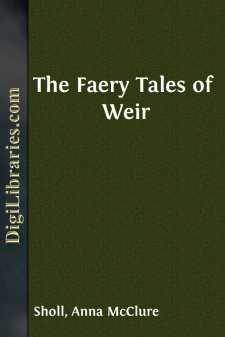Categories
- Antiques & Collectibles 13
- Architecture 36
- Art 48
- Bibles 22
- Biography & Autobiography 813
- Body, Mind & Spirit 142
- Business & Economics 28
- Children's Books 17
- Children's Fiction 14
- Computers 4
- Cooking 94
- Crafts & Hobbies 4
- Drama 346
- Education 46
- Family & Relationships 57
- Fiction 11829
- Games 19
- Gardening 17
- Health & Fitness 34
- History 1377
- House & Home 1
- Humor 147
- Juvenile Fiction 1873
- Juvenile Nonfiction 202
- Language Arts & Disciplines 88
- Law 16
- Literary Collections 686
- Literary Criticism 179
- Mathematics 13
- Medical 41
- Music 40
- Nature 179
- Non-Classifiable 1768
- Performing Arts 7
- Periodicals 1453
- Philosophy 64
- Photography 2
- Poetry 896
- Political Science 203
- Psychology 42
- Reference 154
- Religion 513
- Science 126
- Self-Help 84
- Social Science 81
- Sports & Recreation 34
- Study Aids 3
- Technology & Engineering 59
- Transportation 23
- Travel 463
- True Crime 29
The Faery Tales of Weir
Description:
Excerpt
THE FAERY TALES OF WEIR
Only in far-away towns are the real faery tales told in shadowy nurseries whose windows in summer open upon shimmering gardens and on whose walls in winter the fire-goblins dance. Weir is one of these towns—a sweet, hushed place, lying where the hills spread broadly to the south sun, and the trees are thick as in a painting.
There are shops, too, with bulging windows through which you can scarcely see the toys or the flowers or the sweetmeats, because Time has finger-marked the glass with violet and crimson stains that shift and merge so that the contents of the windows are seen as through wavering sea-water. Beyond the shops are the houses asleep beneath great trees, their warm red bricks showing where the ivy has thinned. Their stacked chimneys send out faint blue spirals of smoke, to let you know that the fires are on the hearths and about the hearths the children are gathered.
The little old churches placed where Weir drowses out into the country, have hoarse, sweet bells like the voices of old women who whisper of the Christ Child at Christmas time; and in the churches are windows as full of color as the gardens of Weir.
The sleepy, forgotten town was famous for nothing but its faery tales told long ago to children whose bright eyes have looked by now on wider scenes, and whose voices have died away on that wind upon which all voices sink from hearing at last. I sometimes wonder whether in imagination they all troop back at the twilight hour: Hubert to cuddle up in the wing-chair; James to stretch out on the hearth-rug; Veronica and little Eve to nurse their dolls and gaze through the nursery window half fearfully at the striding dusk, or to listen to the tap upon the panes of flying leaves when the great winds rise. Where is Richard who always wanted "a tale never told before," and small Spencer with his dreaming eyes and baby mouth? Where is quaint Matilda with her plaid dress and her straight black hair; where is Ruth?
Wherever they are, I like to think that to them Weir is always their true home; and their hearts really live in that broad shadowy house where the steps of the staircase were so wide and shallow that each was a little landing in itself; and where the candles flamed at night in high sconces; and in the halls was a rustling of silk; and in the air the smell of flowers and burning wood. The nursery was high up under the eaves, so that the rest of the house seemed far-away—a wonderful region where music might sound, or where, by stealing down, one might see fair ladies like the princesses of the tales smiling at gallant gentlemen. One's own mother might turn, indeed, into a princess just before it was time to go to bed, with white arms and jewels upon her neck.
Then one fell asleep knowing that no day in Weir could be without its enchantment, whether the clouds seemed caught in the tree-tops, or the snow flew and made the red roofs white; or whether the sun danced on the green lawns, for each day ended with a faery tale, and these are the tales of Weir....


